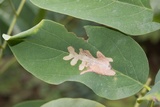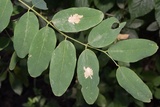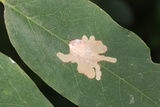Parectopa robiniella Clemens, 1863 Species
Last modified: Feb. 27, 2021, 3:26 p.m.
First discovered in Belgium in 2007 in NA and the next observations were only in 2018 in several provinces from where they start their slow advance over almost the entire country. Nowadays still rare and local.
Details
- Classification
- Family: Gracillariidae > Subfamily: Ornixolinae > Genus: Parectopa > Species: Parectopa robiniella
- Vernacular names
- Acaciawolkje (NL), Locust digitate leafminer (EN), Robinien-Blatttütenfalter (DE)
- First mention in Belgium
- Baugnée J.-Y. 2014. Parectopa robiniella (Lepidoptera: Gracillariidae), a leafminer of black locust Robinia pseudoacacia, new to the Belgian fauna. — Phegea 42(3): 55–57. On page 55. view page
- Status
-
Invasive In Belgium since August 2007.
A Nearctic species introduced into Europe via Italy in 1970. The first record in Belgium consists of some leaf mines on Robinia pseudoacacia, at Hour in the valley of river Lesse (NA) on 17th August 2007, leg. J.-Y. Baugnée.
Distribution
Imago
Head white. Forewing brown with four white striae along the costa and 3 white striae along the inner margin.
Museum specimens
No pictures yet!Specimens in nature
No pictures yet!Caterpillar
Light green.
Mine
The white mine is almost always situated on the upper side of the leaf, covering the central vein and with several small bulges in different directions, this in contrast with the other gracillariid species living on Robinia pseudoacacia (Macrosaccus robiniella) where the mine is situated at the underside of the leaf and is oval-shaped without bulges.
See also gracillariidae.net and bladmineerders.be.
Cocoon/pupa
A whitish cocoon attached to a leaf in the first generation and among leaflitter in the hibernating generation. The spinning contorts the leaf edge.
Bionomics
The egg is oviposited on the underside of the leaf, close to the midrib. The first instar makes a very small mine and then bores through the leaf to the upper surface where it creates an "amoeba-like" mine, a white blotch mine with many bulges in different directions.
Flight periods
There are two or three annual generations, difficult to separate. Adults flying from May till September.
Observed on
- Host plant (species):
- Robinia pseudoacacia
In Europe monophagous on Robinia pseudoacacia, though in the Nearctic region it lives also on other species of Robinia and even on other Fabaceae like: Amorpha fruticosa, Desmodium sp., Galactia volubilis and Meibomia sp.
Habitat
Forest edges, open shrubland, roadsides etc. where the larval host plant grows. Parectopa robiniella seems to prefer a warmer environment than Macrosaccus robiniella and this is perhaps the reason why the species did not become as widespread and common as the last one.



